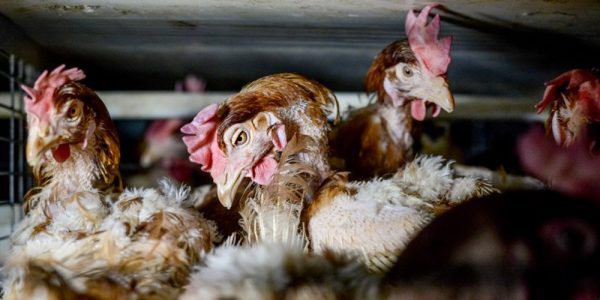Video Transcript
When we think of the way the chickens that people eat are raised, a lot of us think of the ideal family farm in the countryside with happy chickens roaming the fields and a farmer tending lovingly to his flock.
But the reality is very different.
If you’ve ever eaten chicken, they probably spent most of their life in a building like this one.
Chicken farming is currently the most intensive land animal farming industry in the world, in Australia alone over 670 million chickens are raised and slaughtered every year.[1]
But it wasn’t always like this.
Prior to the 1950s chicken farms were small scale, backyard operations and in most cases produced both eggs and chicken meat.
Female chickens would be egg layers, and the male chickens, who couldn’t provide eggs were raised for meat on the side.
Back then chicken was eaten very occasionally, often only for special meals.[2]
However, the birth of the modern supermarket chain,[3] along with the rise of fast food restaurants, meant that by the end of the decade there were large companies with huge marketing budgets pushing more and more chicken meat onto consumers.[4]
To fuel this push to sell more product the industry needed birds that produced more meat. In 1959 they start growing chickens specifically bred for their large size.
Referred to as broiler chickens they grew faster and bigger than their egg laying cousins. Now thanks to decades of selective breeding the modern chicken grows three times faster than the natural rate.[5]
They grow so big so quickly that many cannot support their own body weight and can suffer debilitating injuries, lameness and heart failure. Every year, millions of chickens don’t even survive long enough to reach slaughter weight.[6]
Meanwhile this genetic manipulation is celebrated by the industry as good for business.
Along with changes to the chickens themselves over the last few decades corporate mergers and takeovers have completely transformed the industry.
As a result, production has been centralised onto larger and larger scale farms.
Today, 70% of Australian chicken meat production is controlled by just 2 companies: Inghams and Baiada.[7]
These giant corporations are completely vertically integrated.[8]
They own the multi-million dollar hatcheries where the chickens are born. They own the chickens themselves from birth til death. Finally, they own the slaughterhouses where the chickens are killed at just 6 weeks of age.[9]
This system has been designed to maximise profit[10] and has transformed the role of farmers.
Chicken farmers no longer exist in the same way they did in the 1950s. They’re now known as growers.
Most growers are contracted directly to these huge chicken corporations. The company owns the the birds and the rest of the infrastructure, the growers only role is maintaining the sheds to as many birds as possible, as quickly as possible.[11]
For their work they’re paid no more than 75c per bird. And it’s not just some growers doing it tough.[12] As the ABC reported in 2015:
“The label says 100% Australian grown, and that may be true, what we aren’t told is that these products have been processed and packed by exploited migrant workers many of them grossly underpaid routinely abused at work.”[13]
The report exposed allegations of worker exploitation at some chicken factories,[14][15] and in recent years there have been multiple reports of workplace accidents.[16]
So over the last 50 years chicken meat has become common place and food companies continue to push consumers to buy more and more.[17] Masking themselves with a folksy, rural public image, over decades the chicken meat industry has become a gigantic business. “Big chicken” has built bigger farms, bigger factories and bigger chickens all in the name of bigger profits.






